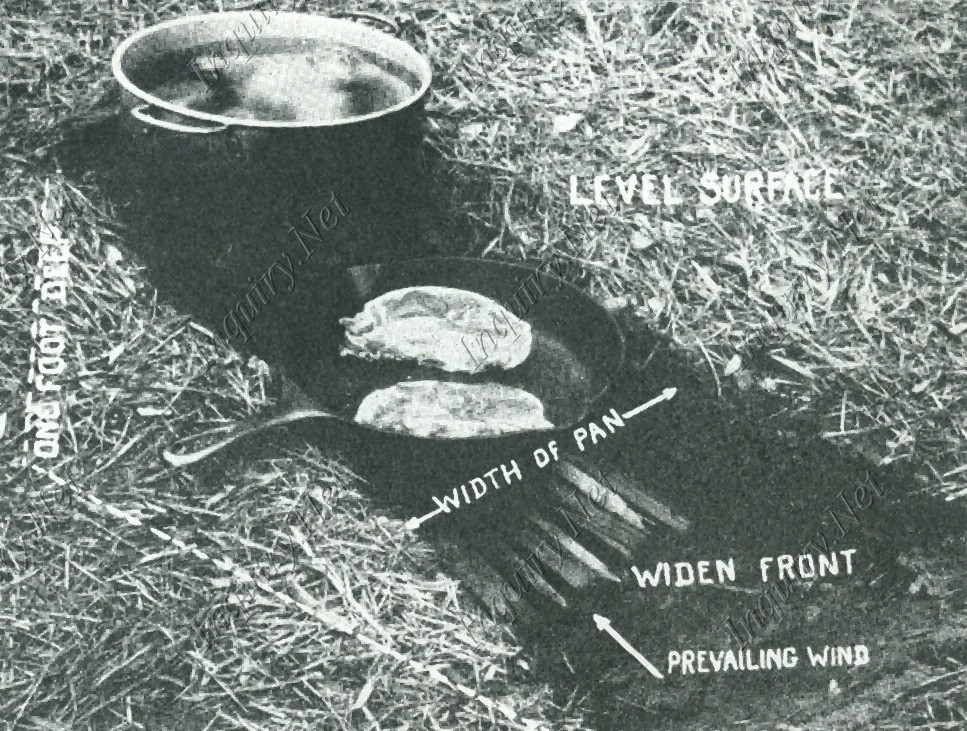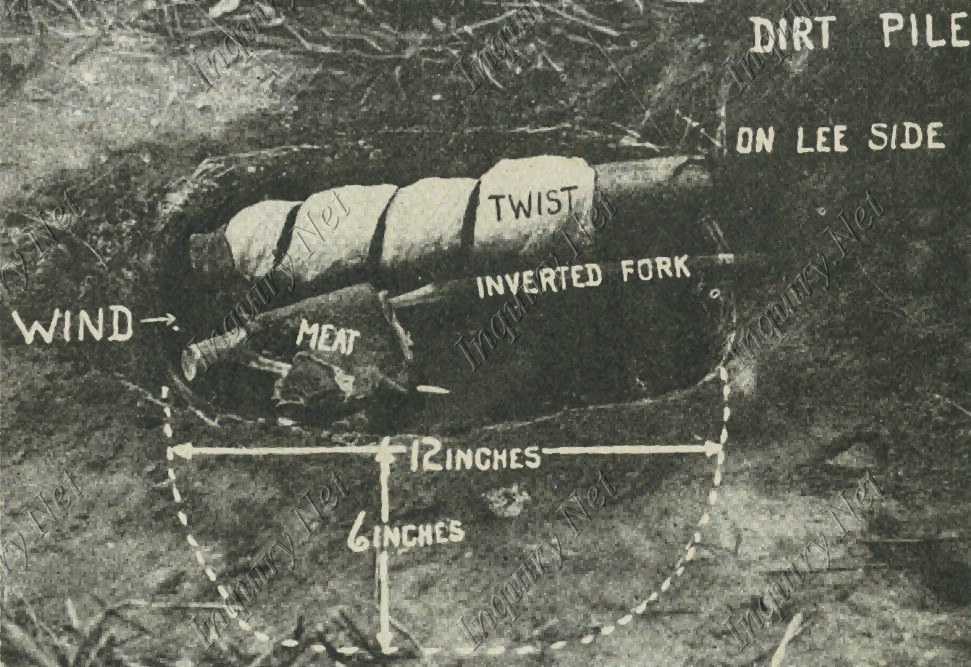PART III
Fires In The Ground
Open Trench Fire (9). Trench fires have not been used much in the United States because wood is still plentiful, and it is less trouble to build a fire on top of the ground than beneath it. They are used principally in parks and reservations, where required by law. However, trench fires are used more than any other type of fire in European countries, where it it is necessary to retain all possible heat in order to conserve fuel. Any fire in a hole is more comfortable to work at in hot weather, for the heat does not radiate as readily from the sides. It is the safest fire to use when the wind is blowing hard, or when the ground is covered with dry grass or leaves.

Open Trench Fire
The trench is made by digging an excavation about twice the length of the space that the pans will occupy. Slope it gradually from the windward end to a depth of about one foot in the rear. Make it a little narrower in the rear than the width of the pans and nearly twice this width in the front. Why? If the soil is sandy it is advisable to line the hole with small stones,
Closed Trench Fire (10). An open trench fire may be easily converted into an all-round camp cooking fire; simply close the deep end and use it as an oven. Line it with firestones, and.' cover it with a thin flat stone or a piece of heavy sheet metal. The fire will burn very much better if a chimney is erected.

Closed Trench for Permanent Camp
1. How should the trench be dug with reference, to the prevailing wind?
2. How would you start a trench fire?
3. Why does a trench fire consume less wood than one built upon the surface of the ground?
4. How would you use a closed trench for baking?
Cooking Fire in a Hole (11). A fire in a hole is good for individual or small group cooking. It can be recommended because it is particularly useful for cooking the kind of food that hikers usually carry. After using it, throw the earth and garbage into the hole to put out the fire, and leave the place clean.

Fire in a Hole—Conservation and Safety
Dig a hole about a foot in diameter and six inches deep, and throw the earth on the side opposite that from which the wind is blowing. If potatoes are to be baked, dig the hole a little deeper and cover the bottom with small stones. If the soil is sandy, line the entire hole with stones..
To start the fire, fill the hole with any inflammable material (such as birch bark, leaves, grasses or dry small twigs), and lay a hardwood crisscross fire over the hole. If boiling is to be done, hang the kettle and light the fire. In a short time the water will boil and the hole will be partly filled with hot coals ready for cooking the rest of the meal.
1. Why pile the earth on the lee side of the hole?
2. How would you use a fire in a hole for baking beans? For baking biscuit? Potatoes?
3. What are the disadvantages of a fire in a hole?
Automatic Stew Fire (12). As its name indicates, the automatic stew fire feeds itself and is used for stewing. After the cook has experimented with this fire several times, and he may leave camp for an hour or more and return to find his stew still simmering.

Automatic Stew Fire
Dig a hole at least a foot deep and a little less than twice the diameter of the stew-pot. Be sure to make the sides of the hole almost perpendicular. Why? Fill the hole with a substantial supply of inflammable material and kindling. Lay a hardwood crisscross fire over the hole, hang the pot on the lug-pole, and light the fire. The stew will boil vigorously until the burning embers fall into the hole. Then lower the pot by hanging it on a pothook so that its bottom is just below the surface of the ground, and stand slow-burning wood vertically around the edge of the hole. When these sticks burn they fall into the hole, replenishing the fire.
Slow Burning Firewoods: Cherry, chestnut, red elm, locust, red or white maple, red oak, and sycamore burn slowly when green, but they eventually form good coals.
1. What are some things that might happen to upset the theory of an automatic stew fire?
2. Would there be any advantage in lining the hole with stones?
Trapper-Trench or Chinook Fire (13). The combination of a trapper and a trench fire, called a Chinook fire, can be highly recommended for a permanent camp since it may be used to cook or bake any camp dish.
Dig a trench as described for Open Trench Fire No. 9 (above), and place a slow-burning log on each side of it. If a camp crane is not used, the kettle may be placed upon the cross-sticks. A close-up view and description of the rustic swinging crane illustrated may be found in Rustic Crane No. 29.
For hard boiling, the kettle should be hung before the fire is lighted. The coals drop into the trench ; when a sufficient quantity has been formed, they may be raked into the shallow end for frying or broiling. For baking, heat two large cross-sticks till they are

Chincolc Fire with Swinging Crane
aglow, place them over the deep end of the trench, close the rear of the trench, draw the coals forward, and place the pan in the oven thus formed. As this oven is entirely surrounded by heat, care must be taken not to let it become too hot.
1. Would there be an advantage in using stones instead of side-logs?
2. how would you regulate the draft if the wind changed?
3. tinder what conditions would it be advisable to line the trench with stones?
4. How would you start this fire?